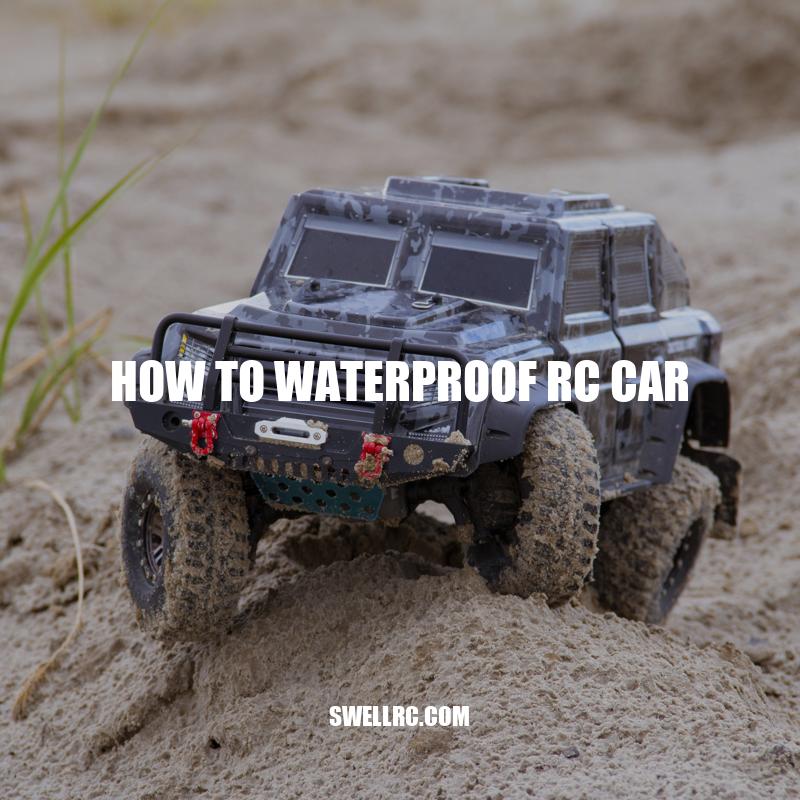Effective Tips to Waterproof RC Cars
RC cars are a source of endless fun for enthusiasts of all ages, and they can be driven in a variety of conditions, including on wet and slippery surfaces. However, the presence of water can cause damage to the electronic components of the car, leading to a reduced lifespan and poorer performance. To prevent this, waterproofing an RC car is crucial. It may seem like a daunting task, but it is relatively easy, and all it requires is the right materials, technique, and some effort. With the steps outlined in this article, you will learn how to waterproof your RC car effectively, making it resistant to water damage and able to take on any terrain or weather conditions. So, if you’re ready to take your RC car adventures to the next level, read on to learn how to protect it from water damage.
Steps to Waterproof Your RC Car
Before you begin, it’s essential to note that the procedure may vary depending on the type of RC car you own. However, the steps we will discuss are relatively generic and can be applied to most models. Here’s how to waterproof your RC car:
Step 1: Disassemble the RC Car
– Remove the shell so that you can access the internal components.
– Take out the motor, the receiver, the battery, and other electrical components.
– Inspect them for any signs of damage. If you find any cracks or holes, repair them before proceeding with the waterproofing process.
Step 2: Choose Your Waterproofing Method
– Use a waterproofing sealant like a conformal coating, liquid electrical tape, or a waterproof spray like CorrosionX.
– Choose a method that suits your RC car model and your purpose. Each method has its benefits, so it’s essential to read the instructions before selecting one.
– Consider using a waterproofing kit that includes all the necessary materials for the job, such as those offered by Rust-Oleum, Pro-Line, or MaxAmps.
Step 3: Apply the Waterproofing Material
– Use a foam brush to apply the waterproofing sealant to the internal components.
– Apply the sealant in a thin, even coat, making sure to cover all the exposed electronic components.
– Wait for the sealant to dry completely before reassembling the RC car.
These are the basic steps to waterproofing your RC car, but more detailed instructions can be found online or in the materials that come with each waterproofing product.
How do I know what RC car to buy?
When buying an RC car, there are several factors to consider to ensure you get the right one for your needs. Here are some tips to help you make a decision:
- Consider the power source: RC cars can be powered by electric or gas. Electric RC cars can be cheaper and quieter, but gas-powered ones can reach higher speeds.
- Type of terrain: Consider where you’ll be using the RC car. Will it be on-road or off-road?
- Size: RC cars come in different sizes, from mini to large-scale models.
- Budget: Set a budget to narrow down your options and find the best value for your money.
- Brand and reviews: Do some research about the brand and read reviews from other buyers.
If you’re unsure where to start, check out websites such as Horizon Hobby or RC Planet, which offer a variety of RC cars and helpful guides to assist you in making your decision.
Protecting the Electronics
RC cars have delicate electronic components that can quickly get damaged when exposed to water. To protect your RC car from water damage, use the following methods:
Waterproof Tape
Advantages: Easy to apply, helpful for difficult angles and corners, provides insulation from shocks.
Disadvantages: Could leave a residue after removal, may not provide complete protection.
Conformal Coating
Advantages: Creates a protective coat around components, does not cause temperature changes, provides insulation from shocks.
Disadvantages: May be difficult to remove if necessary, may require more than one coating for complete protection.
CorrosionX
Advantages: Protects against corrosion as well as water damage, excellent for use in saltwater environments, protects against extreme temperatures.
Disadvantages: May be messy to apply, may leave an oily residue on your hands or car.
These methods help protect your RC car’s electronic components from water damage, which can be devastating. It’s worth noting that the tape and the conformal coating methods may require more than one application for complete protection. Additionally, the tape may not provide complete coverage in some cases. Choose a method that best suits your model and use.
How to waterproof RC car electronics?
To waterproof RC car electronics, follow these simple steps:
- Use a waterproof coating spray on the electronics
- Cover the electronics with silicone or conformal coating
- Use waterproof connectors
- Seal the RC car body with waterproof tape or silicone
Sites such as RC Geeks and HobbyKing offer waterproofing solutions for RC cars.
Maintenance and Inspection
Even after you have successfully waterproofed your RC car, it’s important to maintain and inspect it regularly to ensure continued protection. Here are some tips to keep your car in top condition:
– After each use in wet conditions, inspect the car for any cracks or holes that may have formed.
– Check the waterproofing material (tape, sealant, or spray) periodically, and reapply as necessary.
– If you notice any leaks, replace or repair the damaged parts immediately.
– Use compressed air to blow off any dirt or debris that could cause damage to the car.
– Wipe the car down with a soft cloth that’s dampened with water after each use.
To make the maintenance task easier, you can use some specific products:
Dry Lube
Dry lube is a silicone-based lubricant that can be used to protect your RC car, especially gears, from moisture and dirt. It’s a dry lubricant, which means that it doesn’t attract dirt or dust particles. It’s easy to apply and very effective, making it a great option for keeping your RC car in good condition.
Rust Remover
If you find that water damage has caused rust on some areas of your car, a rust remover can be a great help. Rust removers break down rust and make it easy to clean up. Many rust removers come in spray cans and can be easily applied to the affected areas.
By using these products and performing periodic maintenance and inspection, you can keep your RC car in top condition, and ensure it lasts for many years to come.
Can I spray my RC car with water?
Yes, you can spray your RC car with water, but there are certain precautions you should take:
- Ensure that your RC car’s battery and electronics are protected from getting wet.
- Remove any important parts, such as the battery and receiver, before spraying your RC car with water.
- Use a low-pressure spray and avoid spraying water directly onto the electronics.
- Avoid immersing your RC car in water to prevent damage to the internal components.
Some RC car manufacturers produce waterproof models that can be sprayed with water. For these models, the battery and electronics are protected from water damage. Check the product specifications or consult the manufacturer’s website to determine if your RC car is waterproof.
Conclusion
Waterproofing an RC car can seem daunting, but it’s a task that’s well worth the effort. It ensures your car lasts longer, performs better, and can tackle any weather or terrain conditions. By following the tips in this article, you’ll be able to successfully waterproof your RC car and keep it well-protected.
In summary, to successfully waterproof your RC car, you need to:
– Thoroughly prepare the car for waterproofing.
– Choose the best waterproofing method for your car.
– Protect the electronics with waterproofing materials.
– Maintain and inspect the car regularly.
With these steps accomplished, you can enjoy the thrill of racing your RC car through rain, puddles, and even dewy grass without worrying about damaging your investment.
So, it’s time to get your RC car ready for any kind of terrain! Waterproofing your car will boost your performance and provide you with the opportunity to push your car past its limits. With the right steps and equipment, waterproofing your car will be easy and improve your racing experience incredibly.



